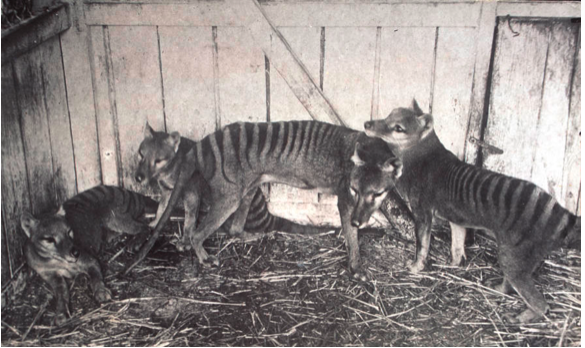Secrets from beyond extinction: Tasmanian tiger was a kangaroo in wolf’s clothing
The Tasmanian tiger genome has been sequenced, making it one of the most complete genetic blueprints for an extinct species.
The genetic blueprint provides crucial new information on the biology of this unique marsupial and how the Tasmanian tiger or thylacine (Thylacinus cynocephalus) evolved to look so similar to the dingo, despite being very distantly related.
It also shows that the thylacine had poor genetic health before it was hunted to extinction in 1936, which may help other threatened species like the Tasmanian Devil.
The work was conducted by an international team, led by the University of Melbourne, and is published today.
The Tasmanian tiger was a marsupial, which are mammals with a pouch.
The genome was obtained from one of the best-preserved thylacine specimens in the world - a 106-year-old pouch-young held in Museums Victoria’s Collection.
The research team used cutting-edge techniques to extract DNA and sequence the genome of this juvenile thylacine.
Project leader Associate Professor Andrew Pask said the results provided the first full genetic blueprint of the largest Australian apex predator to survive into the modern era.
“The genome has allowed us to confirm the thylacine’s place in the evolutionary tree. The Tasmania tiger belongs in a sister lineage to the Dasyuridae, the family which includes the Tasmanian Devil and the dunnart,” Associate Professor Pask said.
Importantly, the genome has also revealed the poor genetic health, or low genetic diversity, that the thylacine experienced before it was over-hunted.
This is a similar fate facing the Tasmanian Devil, which was predicted to be due to their genetic isolation from Australia for the last 10 000 to 13 000 years.
However, the genome analyses suggest that both animals were experiencing low genetic diversity before they became isolated on Tasmania.
Hence, Tasmanian tigers may have faced similar environmental problems to the Devils, had they survived, such as difficulty overcoming disease.
“Our hope is that there is a lot the thylacine can tell us about the genetic basis of extinction to help other species," Associate Professor Pask said.
“As this genome is one of the most complete for an extinct species, it is technically the first step to ‘bringing the thylacine back’, but we are still a long way off that possibility.
“We would still need to develop a marsupial animal model to host the thylacine genome, like work conducted to include mammoth genes in the modern elephant. But the fact that we now know the Tasmanian tiger was facing limited genetic diversity before extinction means it would still have struggled similarly to the Tasmanian Devil if it had survived."
However, he said the genome does provide important new insights into the biology of this truly unique marsupial apex predator.
Scientists consider the thylacine and the dingo as one of the best examples of convergent evolution, the process where organisms that are not closely related independently evolve to look the same as a result of having to adapt to similar environments or ecological niches.
They found that because of their hunting technique and diet of fresh meat, their skulls and body shape became similar through a process called ‘convergent evolution’. This is where, despite not being closely related, adaptation to their environment causes their appearance to become identical.
Working with Dr Christy Hipsley from Museums Victoria, the team analysed the characteristics of the thylacine’s skull - such as eye, jaw and snout shape.
“We found the Tasmanian tiger had a more similar skull shape to the red fox and gray wolf than to its closest relatives,” Dr Hipsley said.
“The fact these groups have not shared a common ancestor since the Jurassic makes this an astounding example of convergence between distantly related species."
Associate Professor Pask said: “The appearance of the thylacine is almost a dingo with a pouch. And when we looked at the basis for this convergent evolution, we found that it wasn’t actually the genes themselves that produced the same skull and body shape, but the control regions around them that turn genes ‘on and off’ at different stages of growth.
“This reveals a whole new understanding of the process of evolution, we can now explore these regions of the genome to help understand how two species converge on the same appearance, and how the process of evolution works.”
In this case, he said: "It seemed the need to hunt led the thylacine to transform its appearance into one similar to the wolf over the past 160 million years, and we can now start to understand the genetics that has driven this process and uncover more about the biology of this unique marsupial apex predator."
The research team also included scientists from the University of Munster, Museums Victoria, University of Adelaide and University of Connecticut. Some of the work was funded by the Research @ Melbourne Accelerator Program.
